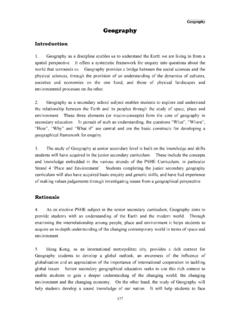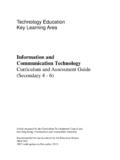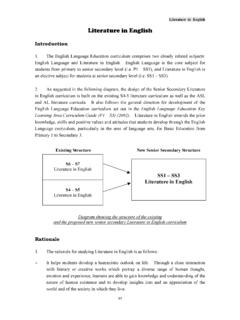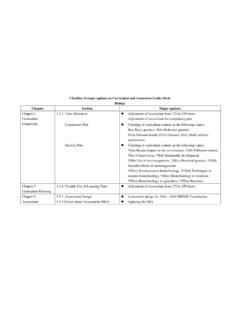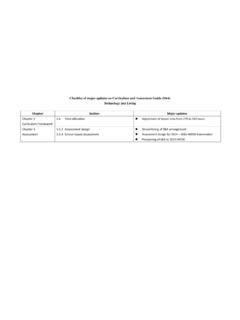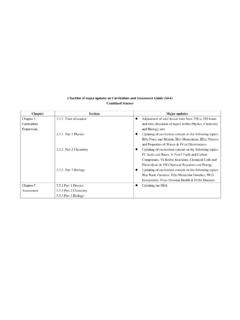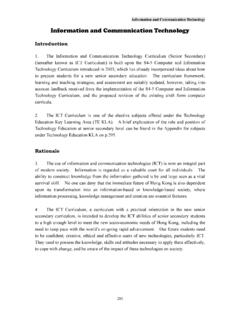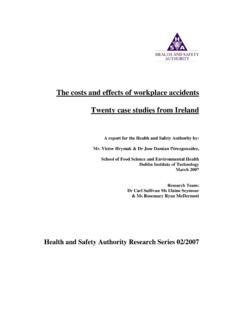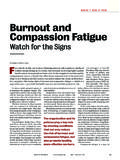Transcription of Physical Education - hkedcity.net
1 Physical Education 329 Physical Education Introduction 1. Physical Education (PE) develops the skills, knowledge, values and attitudes needed for establishing and enjoying an active and healthy lifestyle, as well as building student confidence and competence in facing challenges as individuals and in groups or teams, through a wide range of learning activities. 2. PE is offered as an elective examination subject at senior secondary Education level. It emphasises the connection between theory and practical skills and is designed to develop the interest and potential of students in the areas of PE and sports. It will help students gain a deeper understanding of theories and applications in the fields of human movement and health, and it will promote the well-being of individuals and society. 3. The curriculum for PE builds on the prior knowledge and skills that students will have obtained through the Basic Education PE Curriculum and other Key Learning Areas.
2 The concepts on fitness and health will be strengthened and new elements on sports psychology, biomechanics, and sports and recreation will be added. The senior secondary PE curriculum will continue to enhance the six strands in PE and develop students collaboration and communication skills, creativity and critical thinking skills as a basis for further studies and career development. Rationale 4. It is generally accepted that encouraging a healthy lifestyle characterised by regular Physical activity in children is a world-wide priority for future health to overcome the challenges posed by sedentary lifestyles1. Like many other major cities in the world, Hong Kong is facing the same problems. The PE Curriculum is designed to address the problems of obesity and lack of Physical fitness, by providing students with the knowledge to make an informed choice of lifestyle.
3 Through a combination of theory and practical work, the PE curriculum will foster healthy living and contribute to the development of well-being. 5. The PE Curriculum will also help to promote the development of a life-long interest in sports participation. Over the past few years, a culture of sports participation has been growing. This is partly in response to increased government provision of recreational facilities, Physical activities and health Education programmes, and better access to them, 1 World Health Organisation. (2002). Physical Activity and Health. Fifty-fifth World Health Assembly, Document WHO, Diet, Geneva. Physical Education 330making them more popular. At school level, our students in general enjoy participating in Physical activities, as a result of the unfailing efforts of schools, parents and various agencies ( sports governing bodies, Hong Kong School Sports Federation and Hong Kong Schools Dance Association).
4 In order to sustain this new sportive culture, the PE Curriculum aims to provide the knowledge and skills needed by those who are interested in participating in sports safely and enjoyably. 6. The PE Elective is a three-year course leading to a public examination. It not only builds on the strengths of the existing PE curriculum at Basic Education level but also helps students with an interest in PE and sports to establish a solid foundation for further studies and advancement. The breadth of the Curriculum, with its variety and flexibility, enables students to advance smoothly to higher Education and to possible future careers in human biology, nursing, physiotherapy, occupational therapy, PE, sports and recreation etc. The PE curriculum will contribute to the development of generic skills as well as positive values and attitudes, especially perseverance and sportsmanship.
5 All of this is in line with the appeal from the World Health Organisation (WHO), for the building of a long-term capacity for a healthy community2. Curriculum Aims 7. The aims of the curriculum are to enable students to: (a) acquire a broad range of integrated knowledge, and enhance understanding and skills for further Education and a future career; (b) apply knowledge and skills to make informed decisions and judgments, and to initiate, plan, perform and evaluate PE, sports and recreation, and health activities; (c) enhance generic capacity, in particular, collaboration skills, communication skills, critical thinking, creativity and aesthetic appreciation, as a basis for further studies and career development; (d) develop commitment towards the improvement of individual well-being and the further development of an active and healthy society; (e) become responsible citizens who can demonstrate desirable behaviours and a sense of commitment towards the betterment of their life, community, nation and the world.
6 2 World Health Organisation. (2004). Global Strategy on Diet, Physical Activity and Health. Fifty-seventh World Health Assembly. WHO, Document , Geneva Physical Education 331 Curriculum Framework (This part should be read in conjunction with the section Curriculum Framework of the Main Document. It should be noted that the curriculum framework suggested below is for initial consultation only. Feedback from the public will be taken into account and further details will be provided in the next stage of consultation.) 8. To achieve the aims of the PE Elective, the following modules and time allocation are recommended: Lesson Time: 255 hours Modules Suggested lesson time (hrs) 1. Wellness and Physical Education 20 Definition and Components of Wellness Relationships Between Wellness and Physical Education Relationships Between Wellness and Sport andRecreation 2.
7 Human Body and Movement Analysis 30 Human Anatomy Cardiovascular system Musculo-skeletal system Growth and Development Bio-mechanics Centre of gravity Lever system Motion and force Application of bio-mechanics to Physical activities Movement Control 3. Physiological Basis for Exercise and Sports Training 50 Energy Production Aerobic system Anaerobic system Different sports and energy expenditure Physiological Factors Affecting Performance Age Body composition Cardio-respiratory fitness Cold Drugs Flexibility Gender Heat Heredity Humidity
8 Muscular fitness Somatotype and physique Physical Education 332 Modules Suggested lesson time (hrs) Concepts and Principles of Training Concepts of training Basic considerations in training Training programme for different groups Training Methods Training principles for aerobic exercise Training principles for anaerobic exercise Different training methods Training Effects Detraining Effects 4. Health, Fitness and Nutrition 50 Component of Health Physical health Mental health Social health Health and Exercise Prevention of Disease Coronary heart disease Diabetes Hypertension Hypokinetic degeneration Obesity Food and Nutrition Carbohydrates Proteins Fats Vitamins and minerals A
9 Balance diet Diet and general health Nutrition and Physical performance Diet before, during and following exercise Desirable Practice Healthy diet Habitual exercise Sufficient rest and relaxation No substance abuse Good posture Body Composition and Obesity Body composition Body fat and obesity Weight control Definition of Physical Fitness Components of Physical Fitness Cardio-respiratory fitness Flexibility Muscular strength and endurance Test and Measurement of Physical Fitness Physical Education 333 Modules
10 Suggested lesson time (hrs) Definition of Sports-related Fitness Components of Sports-related Fitness Agility Balance Endurance Flexibility Reaction time Speed Strength Test and Measurement of Sports-related Fitness Exercise Prescriptions 5. Safety, Sports Injuries and First Aid 25 Safety Precautions Common Sports Injuries and Treatments Abrasion Contusion Dislocation Fracture Heat injuries Overuse injuries Pulled muscle Sprain Strain Tennis and golf elbow Factors Leading to Sports Injuries Environmental factors Facilities and equipment Level of fitness Ignorance
